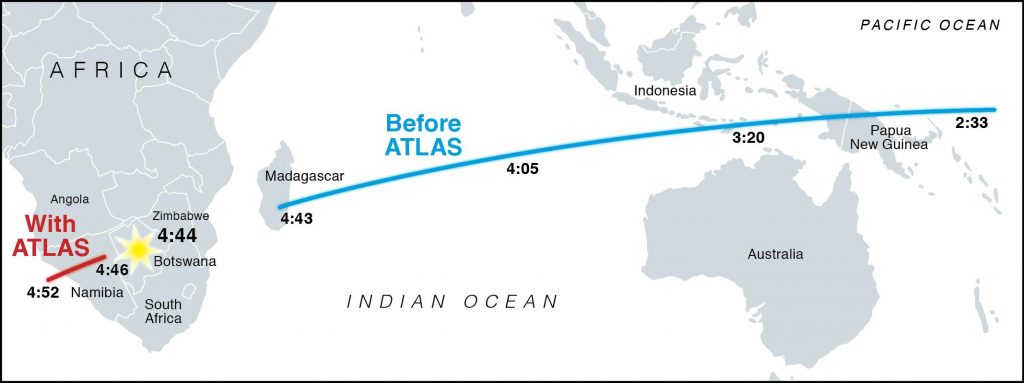Mauna Loa Telescope Helps Pinpoint Meteorite Impact Prediction

Impact time and location predictions for asteroid 2018 LA. The long blue bar shows the predictions prior to ATLAS data being obtained. The much shorter red bar in the image shows the prediction including ATLAS data, while the yellow star marks the actual location. ATLAS clearly made it possible to associate the impact with the observed asteroid. MC: Aren Heinze (IfA/ATLAS), Brooks Bays (SOEST), Bill Gray (Project Pluto)
A multinational team of scientists has just found the first fragments of the small asteroid 2018 LA, which exploded harmlessly high above Africa on June 2.
The University of Hawaiʻi’s Asteroid Terrestrial-Impact Last Alert System (ATLAS) telescope took the final images of 2018 LA before it entered Earth’s atmosphere and exploded.
Although 2018 LA was discovered by a different telescope in Arizona, ATLAS played a crucial role in determining the asteroid’s final destination. Prior to the ATLAS measurement, impact predictions showed 2018 LA hitting the Earth anywhere from Madagascar to the South Pacific—a range spanning almost half Earth’s southern hemisphere.
By measuring the asteroid more than two hours after it was last seen from Arizona, and less than five hours before it exploded, ATLAS greatly improved the accuracy with which the pre-impact orbit could be calculated, helping to prove the bright meteor subsequently seen over Botswana was indeed the fiery demise of 2018 LA.
What makes this especially satisfying to Hawaiʻi’s ATLAS team is that the robotic telescope wasn’t specifically aimed at 2018 LA: It just found the asteroid while automatically scanning the sky—exactly what the telescope is designed to do.
ATLAS consists of two telescopes, 100 miles apart, with one on Mauna Loa on Hawai‘i Island, and one on Haleakalā on Maui. They automatically scan the whole sky several times every night looking for moving objects. The goal of the ATLAS survey is to look in all directions and see asteroids before they can hit the Earth and on June 2, it did just that.
“This is a great test of the system,” said ATLAS Principal Investigator Larry Denneau. “We’ve confirmed that ATLAS can find impactors. If 2018 LA had been big enough to cause a dangerous explosion, like the asteroid that hit Russia in 2013, we’d have had enough warning that people could evacuate the impact zone.”
Luckily, 2018 LA was harmless, but important to science. This is only the second time in history that fragments have been found from an asteroid whose orbit was known prior to its impact with Earth—and when they have been chemically analyzed, we’ll know what kind of asteroid 2018 LA was.
ATLAS currently discovers about 100 asteroids bigger than 30m every year. Were it to hit Earth, an asteroid that size would impact with enough energy to destroy a city like Honolulu. For the first time in history, astronomers can provide sufficient warning to move people away from the impact site.
















